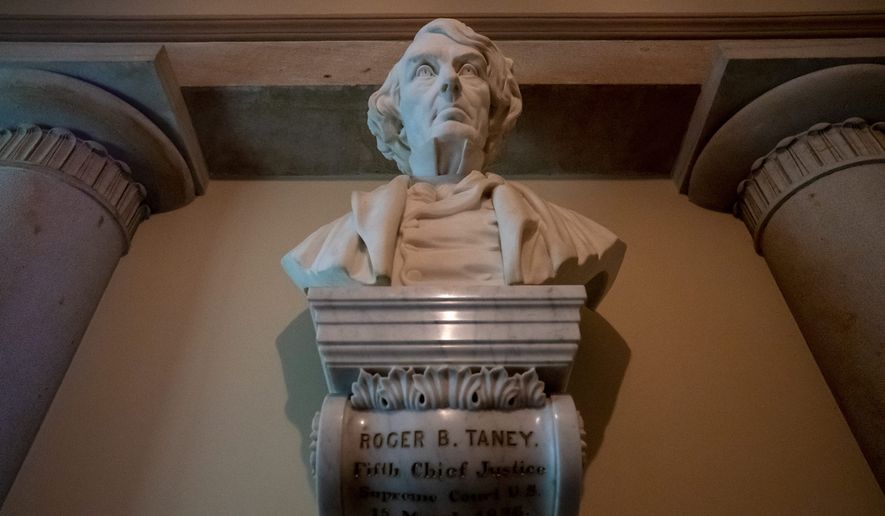House Democrats said Monday they will try to toss the bust of former Chief Justice Roger Taney from the collection in the U.S. Capitol, saying the Maryland jurist’s role in writing the decision in the 1857 Dred Scott ruling makes him unfit for that honor.
The bust sits in the old Supreme Court chambers, now preserved for history, on the ground floor of the Capitol.
House Majority Leader Steny H. Hoyer, Maryland Democrat, said he wants to replace it with one of the late Justice Thurgood Marshall, the first black man to serve on the Supreme Court.
“We’re entering a new era where we are reexamining our history and beginning to look at our history for its good. And also its bad,” Congressional Black Caucus Chairwoman Karen Bass said. “The removal of Chief Justice Taney’s bust is long overdue in our nation’s Capitol.”
The Dred Scott decision confirmed that the Constitution did not recognize slaves as U.S. citizens and therefore they could not sue in federal court. It also declared the Missouri Compromise, a deal meant to appease escalating tensions over slavery, unconstitutional, barring Congress from prohibiting slavery in the western territories.
The decision was overturned by the 13th and 14th amendments about a decade later.
SEE ALSO: Virginia Democrats reverse Confederate monument protection laws
Taney’s role in writing the chief opinion has long been a black mark on his record — and plans to add his bust were controversial even in 1865 when they were raised.
“The name of Taney is to be hooted down the page of history,” thundered Sen. Charles Sumner, who helped doom the idea at the time. It was resurrected a decade later, and his bust was added with Chief Justice Salmon P. Chase.
The push to remove Taney’s bust is part of a larger, national debate over removing statues and monuments dedicated to historical figures who are seen as controversial by modern standards.
In Virginia, the Democratic-led state General Assembly passed measures over the weekend that rolled back protections for Confederate monuments and allows local governments to decide whether or not to remove them.
In Maryland, statues of Taney were pulled from Baltimore and the state Capitol grounds in Annapolis in 2017.
Anthony Comenga, a historian who writes for George Mason University’s Institute for Humane Studies, told The Washington Times that Taney was “pretty horrible” and “among the worst” but ultimately was in line with what the Founding Fathers had written.
“If you want to tear Taney down because he said black people aren’t citizens, what about George Washington? He didn’t lift a finger to help black people, but no one wants to go that far,” he said.
The solution, Mr. Comenga said, is to stop the government from erecting monuments.
“There are very, very few people we should immortalize forever because that leaves us with a tendency to treat the past as some inherited wisdom rather than going forward and doing better,” he said. “It is the sort of thing that provokes people to come into conflict with each other. It is a lose-lose situation.”
Mr. Hoyer said he wished he had moved earlier to remove the bust.
“I’m really not happy with myself because I walked by — being from Maryland — knowing, Roger Brooke’s Taney’s story, knowing the Dred Scott decision and its premise, which I opposed. I’m sorry that I didn’t do this earlier,” he said.
Rep. Andy Harris, the sole Republican in Maryland’s congressional delegation, said he disagrees with the push to remove the bust.
“I do not support denying history by removing Chief Justice Taney’s bust — but instead using its presence as a teaching moment by adding Justice Marshall’s bust, along with a plaque about how flawed the Dred Scott decision was ultimately found to be — the proof being the appointment of Thurgood Marshall,” the lawmaker, who represents Maryland’s Eastern Shore, said in an email to The Times.
Mr. Hoyer said he didn’t want to send mixed signals.
“I don’t want anybody confused [that] they’re good people on both sides,” Mr. Hoyer said, referring to President Trump’s controversial remarks in 2017 after race-tinged violence in Charlottesville, Virginia.
Mr. Hoyer says he hopes the swap becomes a “teachable moment” for tourists and that they are told about Taney’s bust and why it was removed in favor of Marshall, a civil rights icon who argued a record-breaking 32 cases in front of the Supreme Court and won 29 of them — including the landmark Brown v. Board of Education case in 1954.
He served on the Supreme Court for 24 years.
• Jeff Mordock can be reached at jmordock@washingtontimes.com.
• Gabriella Muñoz can be reached at gmunoz@washingtontimes.com.




Please read our comment policy before commenting.